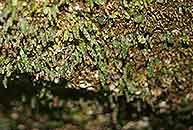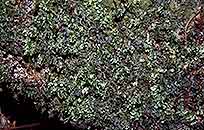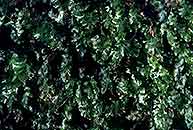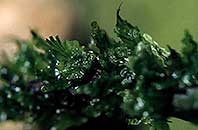Didymoglossum erosum (Willd.) J.P. Roux
Synonyms |
Trichomanes erosum Willd. |
|---|---|
Common name |
|
Description |
Rhizome fine, wiry, wide creepingcovered with very small red brown to dark brown hairs to 1 mm long. Fronds spaced 0.3-5 cm apart, thinly membranous in texture. Stipe short, 0.1-2.5 cm long, dark brown, bearing small hairs like those on the rhizome when young. Lamina dark green, variable in outline, 1-6 × 0.3-3 cm, elliptic, oblong-ovate or obovate, simple to pinnatifid, margins variable, entire or irregularly lobed, base attenuate, glabrous but with simple or stellate hairs when young, especially on midrib and margins, midrib strong, pinnately or flabellately branched in larger fronds, false marginal vein present, false veinlets many. Sori borne in the upper half of the frond, tubular, narrowly bell-shaped, up to 2.5 mm long, with rounded entire valves and winged by the lamina throughout its length. |
Notes | Probably often overlooked or confused with a liverwort. However easy to recognize by its very small, simple and membranous leaves. |
Derivation | erosum: with an irregurly toothed, lobed margin. |
Habitat | Deeply shaded moist evergreen forest, usually near water, on shaded rock, low on tree-trunks, or on moist stream-banks. |
Distribution worldwide | Africa, Madagascar, Réunion, Comoro Is., Seychelles. |
Distribution in Africa |
Angola, Burundi, Cameroon, Central African Republic, Chad, Congo, Dem. Republic of Congo, Equatorial Guinea (incl. Bioko), Ethiopia, Gabon, Ghana, Guinea, Ivory Coast, Kenya, Liberia, Malawi, Mozambique, Nigeria, Rwanda, Sierra Leone, South Africa, Tanzania , Togo, Uganda, Zimbabwe. |
Growth form |
Epiphytic, lithophytic, terrestrial. |
Literature |
|



